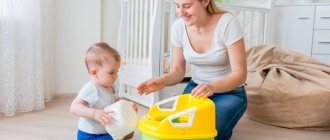June 29, 2018
Averyanova Sveta
A one and a half year old baby is an interesting creature who has to learn vital skills. This is eating liquid food with a spoon, drinking from a glass, drawing with a pencil and, of course, the science of neatness.
It is important for parents to know when to potty train their child and how to do it correctly, so as not to make mistakes and not harm the baby’s psyche.
When to train
Questions: “At what age should I start putting my baby on the potty? And how long does the learning process last?” are probably the most important. Before answering them, let’s understand the intricacies of the psyche and physiology of a toddler.
From the point of view of domestic pediatricians, the baby must have some self-care skills and a certain level of development to begin toilet training.
This:
- Be able to bend, sit down, lift objects, and place them on the table.
- Understand adult speech.
- Be able to communicate desires with gestures or words.
- Feel disgust towards soiled pants.
- Stay dry after a nap, about two hours during games and walks.
The development of these skills gives parents the right to begin teaching toilet etiquette, that is, closer to 18 months .
Forcibly creating a reflex at an early age will lead to nothing. The baby does not yet control the fullness of the intestines and bladder. For this reason, pottying from 10-12 months is a waste of time .
Russian professor Alexander Kazmin identifies several stages in the formation of neatness skills in children under 3 years of age:
- At 1 year to 14 months, the baby feels the first negative emotions about wet pants.
- At 1.5 years old, he worries and freezes if he feels the urge to pee or poop.
- At 20-22 months, he expresses his readiness to go to the toilet with gestures, pulling on his mother’s hand.
- A two-year-old baby can take off his pants and sit on the potty on his own. The urge to urinate occurs every two hours.
- At 2.5 years old, he asks to go to the toilet, expressing his desire in words, and runs to the toilet until he has a bowel movement.
- At the age of 3 he recovers without the help of others: he sits on the potty, takes off his clothes and puts them on himself.
Thus, the optimal age for starting toilet lessons is from 1.5 to 2 years . The baby will prepare for them physically and psychologically.
If you want to thoroughly understand at what age to potty train a child and when to wean him off diapers, watch the video of child psychologist Marina Romanenko .
When to teach?
If the baby is no longer afraid of the potty, it is advisable to immediately begin this stage of training. It may require more time from parents than expected. Psychological help will only be a plus when the mother or father deals with this issue together.
It is strictly forbidden to force a child - if the mother insists on using the potty, and the father sometimes allows him to go “under himself”, the baby will not learn anything good.
Tactics are important:
- Parents should work together to ditch diapers;
- Choose the right season - in winter it is more difficult to carry out this process. In the summer - you can allow your child to embarrass himself on the street and at home;
- Praise is the only source of understanding the correctness of a child’s actions.
So, the baby tried to pee in his toilet for the first time. The music started playing and the parents were happy.
Next, the main method of manipulation will be a smile and applause.
You need to praise your child when he manages to relieve himself in the potty. If the baby could not resist going to the sofa, floor, carpet, you should not pay attention to this yet, but immediately put him on the potty. Ask him to finish everything. It is also recommended to use the “good-bad” method and not be afraid to make comments.
Intonation is also important: the baby understands that peeing in your toilet is great, but anything else is bad. No one is happy about this, mom doesn’t praise it.
Toilet training a child
Parents also believe that a free method of training, when he is asked to independently choose whether he wants to sit on the potty or not, can be safe for the baby’s psyche. For several days, they allow you to wet your pants without changing your child’s clothes. Thus, he gets tired of walking around wet and decides to do everything in the potty himself.
Not all children are predisposed to this, and some of them may think that their parents don’t care, they don’t take care of him without changing him into dry pants. The child may cry, be nervous, but not go about his business. In such cases, the main thing is not to miss the moment when the baby wants to sit down, or is afraid to try it himself.
Some children easily learn this technique, spending from 20 minutes to 2 weeks on training. Here it is important to show with emotions that the baby did it, and he did well.
Parents simply dream that their child will quickly master the potty. How to quickly potty train your child - read useful tips and put them into practice.
You will learn from this information how to teach your child to read quickly.
You can read about the age when it is best to potty train a child in this topic. What is wrong with teaching a child early?
Early training problems
When starting to potty train a baby too early, for example at 7-10 months, mothers are faced with negative consequences that will appear a little later:
- The little one used to sit on the night vase, but by the age of one or a year and a half he stopped sitting on it, crying and getting irritated.
This is due to the fact that the child has developed natural control over the desire to go to the toilet. The treasured “wee-wee” simply doesn’t work on him. He wants to wait for the need, the urge to urinate from the body, and does not stop obeying his mother.
- Unstable neatness skills.
The baby goes to the potty occasionally, expects his parents to sit him down and make appropriate sounds for the urge to go to the toilet. For example, the sound of gurgling water, grunting for bowel movements from the mother.
- Protests by the little ones lead to aggression on the part of the parents.
Mothers, upset by the misbehavior of small children who recently sat on the potty and did not cry, use force. They force me to sit on a vase for a long time and scold me. But the baby does not understand the reason for the dissatisfaction and denies it. A fear of the potty develops.
Patience helps you avoid these problems. Don't rush things. Start teaching neatness on time - at 18-24 months, when you see the first desire to acquire a skill.
Practical advice for parents of sons
Of course, the surest method of teaching an important skill is the personal example of dad. After all, at the age of two, children really like to copy the behavior of adults. If the family is incomplete (the child is raised by one mother), then a grandfather, uncle, or older brother can come to the rescue.
Parents often worry that their son cannot urinate while standing. There's no need to make a problem out of it. He will soon realize that he will be more comfortable standing, especially if he sees it a few times like the other boys or his father do.
Benjamin Spock
https://lib.komarovskiy.net/priuchenie-k-gorshku.html
It is best to show your child an example somewhere in nature during the warm season. Dad (or another close male person) invites the boy to water the grass and shows how it is done. Most children find this very funny.
If it’s winter outside, then dad invites his son to go to the toilet with him and shows him how to relieve himself properly. At the same time, the adult draws attention to the fact that the penis must be held with your hand so that the stream falls directly into the toilet and not past it. Then the adult presses the flush button or invites the child to do this (children usually like the sound of water bubbling).
It should be taken into account that a regular toilet for a small child will be too high. Therefore, the following devices will come to the rescue:
- A special children's stand or an ordinary small bench. Just don’t need to buy products in the form of a ladder with handrails - they help the child get into a sitting position.
For a small boy, a regular toilet will be too high, so a special children's stand will help out.
- A wall-mounted removable urinal that can be hung at any convenient height. After the boy has done his business, the mother simply removes the removable part and pours the liquid into the toilet.
The wall-mounted urinal can be placed at a height corresponding to the height of the boy
Another option is when teaching your son to lift the potty towards the baby’s penis so that he can certainly get into it. Over time, the distance between the potty and the child's genitals becomes greater.
Some boys prefer to lift the potty themselves and hold it in front of them.
You should also know about another useful invention that helps your baby get used to peeing while standing - a children's camp urinal. It will be very useful for a boy's urination, for example, during a car trip. The urinal has an unusual design - in the form of a funny animal (elephant, frog, duckling, etc.). The child will be interested in “giving the elephant something to drink,” and the mother will be calm that the liquid will not spill, and the baby himself does not need to be taken outside to urinate if, for example, it is cold or raining.
A travel urinal will strengthen the boy’s ability to pee while standing and will help parents out on the road.
Video: a simple toilet device that will teach a little boy to pee while standing, hitting the target
Video: children's wall-mounted urinal for boys
Video: camping urinal for boys
5 game techniques
You can include play moments in the process of mastering a male skill (this is especially true if only one mother has to teach the boy). You can use these ideas:
- Place a small object (for example, a piece of foam plastic) at the bottom of the pot, which the boy should hit with a stream.
- Another unusual idea from one of the parent forums is to freeze cubes of colored ice (color ordinary water with gouache). One cube is placed in the pot: when the child pees there, the liquid will turn a bright color.
An unusual idea is to put a cube of colored ice at the bottom of the pot - after peeing there, the baby will see the colored liquid and be surprised
- You can learn to write standing up in the bathroom. The mother turns on the water and shows the child that it flows into the drain hole. The baby should also get there.
- Also in the bathroom, you can offer to “rain” rubber or plastic toys (after which they are thoroughly washed in warm water and soap and treated with an antibacterial agent).
- You can talk about fountains (show the corresponding video), and then invite the boy to arrange a fountain (again, in the bathroom).
Signs of readiness to learn
Take a close look at your child. Determine the degree of readiness for pottery by the following criteria:
- The child is over 18 months old.
- He is happy and dry for one and a half to two hours.
- Understands what pooping and pooping means.
- Cries if he wets himself and puts on his panties.
- He knows how to let his mother know that he needs to go to the toilet (he gets nervous, pinches his legs, freezes, pulls her hand, knows how to wait, etc.).
- He wants to take off his clothes and put them on himself, and he succeeds.
- He knows where his arms, legs, butt are, knows how to show them and name them.
- He sits quietly playing a game and watching cartoons for a few minutes.
- Fulfills some requests: go, bring, give.
- Points to wet panties, expressing dissatisfaction with a grimace.
If your baby belongs to the group of children who can do it all or really want to learn it, then you can start learning toilet literacy. If not, delay the parenting process for a couple of months.
Which pot to choose
The ideal potty is not pink and blue, purchased based on gender, but one that meets the anatomical features of the child’s body structure. You need to select it according to the following characteristics:
- Form . Boys - oval, girls - round.
- Presence of a protrusion . Required for boys.
- Thermal conductivity of the material . A cold pot causes unpleasant emotions, a feeling of disgust towards the procedure. Opt for plastic models.
- Comfortable seating . The first potty should be suitable for height and butt size. Buy the version with a backrest. The baby will comfortably lean on it at night, early in the morning, peeing half asleep.
- Sustainability . The safety of the baby is ensured. The edges should be pressed tightly to the floor. Distortions and bends in the frame are typical for defective products.
- Pot without additional functions . Leave the songs and lighting for musical toys.
Which pot to buy and when
When parents want to potty train their child, they often go to extremes. Some people buy models with special belts designed to fasten a child. This is outright overkill, which never leads to good consequences.
Also, by giving preference to a pot with decorative elements, music and other oddities, mom and dad run the risk of confusing their child. The child will most likely mistake the new acquisition for a toy and behave with it accordingly.
◊ The pot must be:
- simple (without any hassles - belts, wheels, lights);
- plastic (material with high thermal conductivity);
- suitable in size;
- comfortable (preferably with a backrest);
- stable (so as not to roll back and forth on the floor).
Remember : for girls - round, for boys - oval with a special protrusion. You can buy a potty with a removable bowl or a high chair with handles. The color of the item does not matter.
It makes no sense to buy a potty in advance, as it will just sit there and be an eyesore, once again reminding you that the baby is still wearing diapers. It is optimal to make a purchase a week or two before the start of teaching your child the skills of going to the toilet.
Useful tips
For effective toilet training, parents can use some tips and tricks:
- Follow the regime and system of action. Avoid diapers. Don't stop putting your child on the potty every hour or two, after sleep and meals.
- Bring the night vase to your child, rather than leading your child to it.
- Wear simple clothing, without fasteners or zippers. It is important that it is easy to take off and put on.
- Don't keep your baby on the potty for too long. Five to seven minutes is enough. The night vase should be within sight and reach of the child. In this case, he will be able to sit down and defecate on his own.
- Let your child choose the first potty.
- Do not interfere with your baby if he decides to explore his genitals. Let him know how his body works.
- Make a poster or display to mark the baby's achievements. Glue stars for dry days, give small gifts at the end of the week for being neat.
- Give praise after every successful process.
- Don't scold kids for mistakes. This will provoke a negative reaction.
- If the baby arches his back or yells, do not insist on the process. Let some time pass.
- Offer to defecate outside in the bushes, take spare clothes for a walk.
- Tell your baby that walking in dry pants is good, but wearing wet pants is bad and unpleasant.
- Take a funny photo of your child on the potty. Hang it in your room, let him admire himself, realizing his own adulthood.
- If there are other children in the family, place them in the toilet with the youngest. Let them share useful experience and set an example.
- Do not try to form a habit during a period of illness or bad mood.
FAQ
Does your child not sit on the potty until you remind him?
There's nothing wrong with that. Children are easily distracted from internal sensations. It is normal to remind your child to go to the toilet.
Why doesn't my child want to go to the potty?
- The baby does not understand that this is not a toy, if before this the potty was just standing and the child was playing with it.
- The child is afraid of new sensations. It is unusual for him to go without a diaper and to feel that the process of going to the toilet has changed.
- If your baby refuses to sit on the potty, he may be afraid of doing something wrong, for example, peeing wrong.
- Why did the child stop going to the potty?
Think about whether there have been any changes in the baby’s life—an addition to the family, moving, changing kindergarten, transferring the child to a crib without sides? These factors can cause a child to refuse to go potty. In case of incidents, you should not scold the baby, force him to sit on the potty, force him or shame him.
The child does not sit on the potty in kindergarten. What to do?
Find out how and when children are taken to the toilet in kindergarten. Perhaps the baby is embarrassed to go potty with a group. Then ask the teacher to take him separately. Or it might be the potty/toilet itself, which is unusual for him. Bring a potty to kindergarten, just like at home, then the baby will use it.
Why does a child only ask to use the potty at home?
Potty training consists of a series of steps. First, the baby learns to go to the toilet like an adult at home, then he gradually learns to do it in public places and finally during night sleep. You cannot expect a child to go to the potty everywhere at the same time after starting training. Be patient and give your baby time to master the skill well at home. Tell us how this is done in a public place.
Until what age do children go to the potty?
Potty training will take place from 18 to 30 months - in each case the age will be individual. Gradually, when the baby masters the potty, you can transfer him to the toilet. This usually happens by 3-4 years. Don't forget to use a special circle and a footrest so that your child can sit comfortably.
Let's start the learning process
For a sustainable skill, systematicity and consistency of parental actions is important. Begin the methodical process as follows, without skipping steps, repeating the cycle every day until you achieve success.
- Show your baby the potty . Let him touch it, sit there just like that, without even taking off his panties. Play pee-pee with a stuffed bunny.
- Closely monitor the baby on this day , try to catch him at the moment of the urge to defecate or urinate.
If you feel persistent protest or fear, do not force the baby to sit on the potty. Wait a couple of days. - Invite your baby to the toilet after sleeping or eating . Sit next to him on the floor, recite rhymes, sing songs. The child will feel safe.
- Repeat the process every two to three hours.
- Talk to the baby about the purpose of the night vase . Ask where he should pee, point with your finger, and lead the child to the potty. Get a response with a gesture or phrase.
- Praise for achievements, don't scold for mistakes.
- Comment on actions during the process.
“Now let’s take off our pants and panties, sit down, get a napkin, and wash the potty. Well done, Kiryusha!” Going to the toilet will become a routine with a strict sequence of actions.
Watch a very useful video that explains in as much detail as possible all the intricacies of the process of potty training your baby.
What to Remember When Potty Training Your Child
When toilet training your baby, remember the following.
- Girls take about three months less time than boys to be potty trained.
- Boys must first be taught to sit and write. As you get older, you can encourage standing peeing.
- Children often convey the urge to urinate before they can communicate the urge.
- Achieving nighttime bladder control is much more difficult than achieving daytime bladder control.
- Allow plenty of time to potty train your child.
- Don't try toilet training when there are major changes going on, such as moving out of home or the birth of a sibling.
- Disposable training pants are a good choice between diapers and underwear.
- Avoid onesies and onesies for toddlers who are trying to potty train. Make them wear loose, comfortable clothes that they can take off themselves.
- A potty trained child can also have setbacks and accidents.
Each toddler is potty trained at a different age, which may even be different from the age of their siblings. Most children are toilet trained by age three. Some may take longer. Very rarely, children may have physical problems that make potty training difficult. Don't hesitate to talk to your baby's doctor if you have questions about your child's inability to potty train. or the child begins to get dirty after drying for a long time.
How to potty train in seven days
The technique of Gina Fort, a professional nanny from the UK, has been successfully tested by many parents. Children who are already one and a half years old can be trained and they obey their mother in everything. The weekly technique consists of the following steps:
- We refuse diapers.
Take off the last diaper in your baby's life and boldly say goodbye to him. After a night's sleep, sit the baby on the potty and entertain him for about ten minutes, keeping him in the seat with fairy tales and songs. If there is no result, try again after fifteen to twenty minutes. Don't scold for dirty panties, don't get angry.
- Strengthen the skill.
Keep an eye on the baby all day, at the slightest suspicion of a desire to pee, run for the night vase, sit the little one down and wait for the result.
- Skip the diaper for a walk.
Go to the toilet before going out and immediately after returning home.
- During the last days of the week, regularly encourage your child to use the potty . Especially after sleeping, eating, walking.
Do not forget about praise and sincere joy for the child if he fulfilled your request.
Important ! On potty training days, try to give your baby water more often. This will allow you to use the plastic toilet more regularly and make it easier to consolidate the skill.
The game form also helps very well. Use these pictures and rhymes for gentle and smooth training.
Common mistakes made by adults
When teaching a boy an important skill, you need to be sensitive. After all, sometimes adults make mistakes that ruin all their efforts. It is important to remember the following points:
- It is unacceptable to be annoyed with a child if something doesn’t work out for him (for example, he pees past the toilet or potty). On the contrary, it is better to praise the baby once again, and the puddle can be easily wiped away (in no case should you force the baby to wipe it himself).
- You cannot mock a boy, call him small, compare him with other men in the family (“Look, daddy pees standing up, but you don’t know how”). This can only cause resentment, complexes and reluctance to learn.
- After urinating, you should not forget about subsequent hygiene procedures: you need to teach your child to flush after himself and wash his hands thoroughly.
- The formation of adult skills should not be left to chance (“when you grow up, you will learn on your own”).
It is unacceptable to scold a boy, shame him for not being able to pee standing up, or reproach him for puddles on the floor.
When I worked as a teacher in a kindergarten, one of my colleagues very emotionally told everyone how she had to teach a three-year-old boy to write while standing, who had just joined her group (he had not attended kindergarten before). The child was raised by one mother, who obviously did not pay any attention to this issue. I think no parent would want their child to become the object of such a discussion in a preschool institution. Therefore, it is worth taking care of acquiring important skills in advance.
Training boys and girls
Gender also matters for the speed of skill formation and its consolidation. Girls learn to potty train faster because of their flexibility, desire to be beautiful, and to imitate their mother in everything. They are attentive, measured, they are not bored sitting on a night vase, listening to their inner sensations.
Sometimes shyness gets in the way of girls. They refuse to sit down without panties in the presence of strangers, other children, and prefer to endure for a long time. This can be easily fixed by creating a secluded environment for the baby.
Boys are hyperactive, active, enthusiastic natures, so it is extremely difficult to keep them in one place. The father should practice writing with the boy, but this is ideal. Mothers have to take on this role themselves. Dads just have to show them later how to pee standing up.
There are no significant differences in the methods of teaching neatness to boys and girls, especially in the first stages.
Later, when future men learn how to pee not in their pants, but in a potty, they need to quickly teach how to do this more carefully so as not to splash the floor. Leave this part for dads.
Potty training a girl and a boy, are there any differences?
⇑ The gender of the child does not matter much when it comes to how to quickly potty train him. The fact that girls 1.5-2 years old learn faster compared to boys is nothing more than a myth. Also, the presence of shyness and withdrawal in children of this age is associated not with their gender, but with their upbringing.
But, since many parents begin to instill muscular and feminine habits in their children from an early age, some differences in behavior and thinking are still observed. As a rule, they appear closer to the age of two. Boys are more active and cheekier than girls, have difficulty concentrating and have problems with perseverance.
Therefore, in order to potty train a boy, you need to interest him. You can buy books in advance that show how animals go to the toilet, just like people do. The boy should have an interest in this process.
✅️ In order to potty train a girl, you need to leave her alone with her mother so that there is no one else in the room. The environment should be calm, so it is best to close the window, draw the curtains and turn off the TV in advance. In this case, the mother should be shown how to use the potty (for example, pretend that she peed in it herself), and then go about her business, carefully watching the baby.
These rules only work in cases where children aged 1.5-2 years actively display behavioral characteristics characteristic of their gender. But most often, boys and girls are taught the same way. Most children require an intimate environment, the presence of one parent, and the absence of extraneous sounds and distractions.
Reasons for possible failures
It is possible to suffer a temporary fiasco in toilet science even with very flexible and developed children. There are several explanations for this:
- The baby is teething. Postpone the lesson. Discomfort and pain in the mouth do not allow the baby to concentrate on the urge to urinate.
- Passion for games. A child may not want to be distracted from an interesting activity, preferring to wet his pants. This will pass with time.
- Individuality development. Not being potty trained does not mean that a child has intellectual problems. You just have to wait and the process will improve. It's never too late to develop neatness and neatness.
- Year 1 crisis. The child protests, learns to defend his opinion, and shows dissatisfaction with adults.
- Girls learn faster than boys.
- Hyperactivity.
It is simply impossible to keep a nimble baby in place. He doesn't have time to sit on the potty in time, so he has to run around wet. You will have to put in more effort than with a calm baby, and everything will work out.
If your child is afraid of the potty
Fear of the night vase in children is due to the following reasons:
- Unsuccessful introduction to the potty . It was cold, wet, and simply a scary object for the baby.
- Trauma . The kid fell off him and hit himself.
- Lack of support and praise from parents . At the first stages of toilet training, the final result is necessary only for adults; the baby tries to understand what you want from him, tries to please his mother. Don't be greedy with kisses and hugs.
- Untimely training . Parents tried to develop the reflex by violent means at a very early age, acting obsessively.
- Lack of normal conditions for peeing and pooping in the kindergarten.
- Sitting on the night vase for too long . Strict parents achieve results by holding the baby on the potty for several hours, expressing dissatisfaction with the child’s sluggishness.
- Children's fantasies . The kid draws scary pictures in his head about monsters in the toilet. He screams and gets hysterical at the first attempts to sit him down. Ask your child about it and check out who lives there together.
- Pot too big . The baby sits awkwardly, afraid of falling through.
- Constipation . The baby associates painful sensations during bowel movements with the potty. Explain to your child that a plastic toilet has nothing to do with it, change the children's menu so that hard feces do not bother him, and the baby poops painlessly.
You can correct the situation as follows:
- Let the situation go for a couple of weeks, even months. Move the pot away.
- Don't scold your baby. The less you freak out, the calmer the child will become.
- Create a comfortable psychological environment at the time of defecation and peeing.
- Buy a new pot. Let the baby choose for himself.
- Place the potty in the room first and let the child get used to it externally.
- Explore a new object for your child together, place a toy on it, and show how to use it.
- Come up with a fairy tale about magic pots and brave boys who overcame fear and became strong and brave.
Talk about this topic more often.
Important ! Lack of pressure from parents, patience, and help in overcoming a phobia help the baby not be afraid of the terrible potty and get used to the new procedure faster.
How to teach a child to get up to potty at night
Night writing is the next stage in developing the child’s neatness skills. Start it after you have established the process during the day; the baby sometimes remains dry for ten to sixteen hours in a row.
You need to start waking up at night with the following:
- Don't put on a diaper before bed. Place a waterproof diaper on the mattress for protection.
- Wake your baby at certain hours at night. For example, four to five hours after falling asleep. It is important not to grab a sleepy child and put him on the potty, but to explain why he woke up.
- Motivate your baby, praise him for waking up on his own or asking him to urinate at night.
- Talk through night toilet situations during the day. It can be in the form of a game. Wake up and send a doll or a bear to urinate. Let the baby take off their panties himself and praise them for “pee-pee.” You need to have fun playing.
- Spend a couple of nights in the same room with your baby.
If the baby wants to pee at night, he will start tossing and turning and moaning. Place your baby on the potty. In a couple of days he will begin to wake up on his own, and not endure it.
According to Dr. Komarovsky, parents should not take any action to prevent the baby from peeing at night. The ability to stay dry always appears on its own as the bladder grows and holds more fluid. He made videos and wrote articles on this topic.
Watch Dr. Komarovsky's program, entirely dedicated to how to teach a child to go potty.
Physiological method to teach sitting on a potty
Three components are taken into account.
The first is the maturity of the central nervous system . Why is it important? The nervous system is responsible for the innervation of the muscles, gastrointestinal tract, and organs of the genitourinary system. The child gives signals when he wants to go to the toilet. Parents “read” them.
The second is physiological maturity. The child must have strong intestinal sphincter muscles and bladder to control the act of bowel movement.
The third is psychological readiness. The baby must understand your speech, fulfill requests, understand what is expected of him - this makes it easier to teach him to sit on the potty.
Physiological method: nuances
First, consider the child's developmental level. Help him, be patient, don't get angry at failures.
Secondly, the child is the main figure. Respect him, increase your self-confidence. Tell me how mature and independent he is. This way you can teach him to go potty and increase his self-esteem.
Third, introduce your baby to his body. He will learn a new skill faster.
How to wean yourself off diapers
Giving up diapers during the daytime is easier than at night. Don’t wear reusable panties at home, and in kindergarten too. Use the children's toilet before going out. On the street, periodically invite your baby to run into the bushes or take the potty with you.
Praise your baby if he asks to go home because he wants to pee. Soon you will be able to endure it longer; you won’t need spare clothes. Limiting what you drink two to three hours before bed will help you stay dry at night.
You should not categorically refuse night diapers until the age of 2 years. Afterwards the child will wake up and ask to go to the toilet. And wet sheets will help with this. During this period, mothers will have to sensitively and often approach the crib to check the dryness of the panties, change the sheet, and lift the baby to pee.
How to teach a child to ask to go to the toilet at night
Often, children control their processes during the day, and during sleep they may not feel the urge to urinate, since this is very difficult for little ones.
However, if you are determined to give up diapers completely, be prepared to sleep very lightly for some time.
As soon as the child begins to spin and groan, then you should carefully wake him up and put him on the potty. Of course, the result will not appear immediately, so you need to be patient, have spare diapers, sheets, or put an oilcloth in the crib. But under no circumstances should you abruptly interrupt your child’s sleep or jerk him, otherwise he will get scared. Sooner or later your efforts will be crowned with success.
Some more useful tips:
- do not let your child drink a lot of fluids before bedtime;
- offer to sit on the potty before going to bed;
- Turn on a dim nightlight to make getting up more comfortable.
When to see a doctor
You should seek medical help if:
- The three-year-old child has not developed the skill of neatness .
In the fourth year of life, the baby does not feel the need to stay dry. Doesn't pay attention to wet pants during the daytime.
- Continues to write at night at age five .
In this case, we talk about developmental pathologies and congenital anomalies. Involuntary bowel movements and repeated uncontrolled urination are signs of functional and mental disorders.
Contact a pediatrician, urologist, and with girls, a pediatric gynecologist. The specialist will prescribe an examination: ultrasound of the kidneys, bladder, urine test. If the functional system is developed without disturbances, no pathologies have been identified, contact a neurologist.











